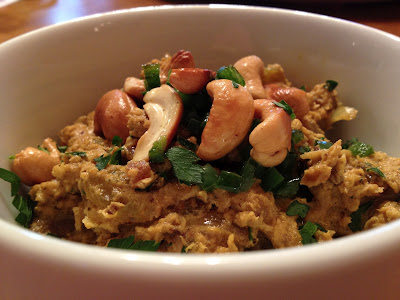I've decided to tackle India from north to south. So, my first dish is from the northern, temperate region described in yesterday's post.
 |
| Cardamom Pods (en.wikipedia.org) |
Kashmir, a hotly disputed territory between India, Pakistan and the People's Republic of China ever since British rule of the subcontinent ended in 1947, is credited as "home" for these curried lamb meatballs. They're easy to make - and
absolutely delicious - but they did require a somewhat heavy lift by my spice cabinet.
I tried to substitute certain spices, like whole cloves and cardamom pods, with ground versions rather than buy "duplicative" items. Honestly, I probably should invest in some whole cloves. The cardamom substituted with no problems, but cloves are a uniquely pungent spice that is tricky to moderate. Just a pinch of ground cloves overpowered even the garam masala. Live and learn...
If that wasn't enough, my rice dish also gave me problems! I cooked the rice for
twice the amount of time as instructed and it
still came out crunchy. That's never happened to me before! Frankly, I was starving, thanks to the delectable aromas from these dishes, so I couldn't wait. I scooped some of the cauliflower and onions off the top and left the rice to finish. Even without the rice, it was amazingly good.
 |
| Whole Cloves (en.wikipedia.org) |
These dishes are well paired, using many of the same seasonings, and I highly recommend them both - even with all tonight's minor snafus. So, here's how I made them:
LAMB:
1½ lbs. ground lamb
¼ cup garbanzo bean (chickpea) flour
3 Tbsp. Garam Masala
¼ tsp ground cayenne
Salt, to taste
6 Tbsp plain fat-free yogurt, divided
2 Tbsp oil
3-inch cinnamon stick
½ tsp ground cardamom (or 6 green pods, bruised)
2 bay leaves
6 whole cloves (I used probably ⅛ tsp of ground, and it was too much.)
2-inch piece fresh ginger, peeled and grated
1 cup water
Fresh cilantro or parsley, minced, for garnish (optional)
RICE:
1¼ cups basmati rice, rinsed
2½ cups water
3 Tbsp oil
8 whole cloves (I used the tiniest pinch of ground, and it was actually OK.)
¼ tsp ground cardamom (or 4 black pods, bruised)
1 bay leaf
3-inch cinnamon stick
1 tsp whole black peppercorns
1 tsp cumin seeds
1 tsp coriander seeds
Salt, to taste
1 small cauliflower, cut into florets
1 small onion, sliced into rings

Rinse the rice in a sieve till the water runs clear, then soak it in a bowl with 2½ cups of water for 30 minutes.
Meanwhile, make the meatballs by combining the lamb, flour, Garam Masala, cayenne, salt and 3 Tbsp of the yogurt in a bowl. Mix well and shape into 16 oblong meatballs.
Heat the oil in a large skillet over medium-high heat. Add the cinnamon, cardamom, bay and cloves and sauté for about 30 seconds before adding the meatballs to the seasoned oil. Brown them well on all sides, about 5 minutes. Then, add the ginger and cook for a couple minutes more. If the meatballs have released a lot of grease, try to skim off as much as possible before proceeding.
Mix the remaining 3 Tbsp of yogurt with the water and add it to the pan. Bring to boil, reduce the heat to low and simmer till the meatballs are cooked through and most of the liquid is absorbed, about 30 minutes. (Cook's Note: If your sauce doesn't come out creamy, try it in reverse. Add some of the cooking liquid to a ½ cup of yogurt and blend well. Be sure you skim the oil from the cooking liquid, or you might end up with the same problem.)
While the meatballs cook, finish preparing the rice. Heat the oil in a large saucepan over medium-high heat. Add the cloves, cardamom, bay, cinnamon, peppercorns, cumin and coriander. Sauté for about 30 seconds, then add the onion and cook them till soft, for about 5 minutes.
Drain the rice, reserving the soaking water. Fry the rice with the onions and seasoned oil for a few minutes till lightly golden. Add the reserved water, salt and cauliflower. Bring to boil, reduce the heat to low and simmer till the liquid is absorbed and the rice is cooked, about 12 to 15 minutes (in theory).
When everything is ready, add the fresh herbs to the meatballs, serve and enjoy!



































